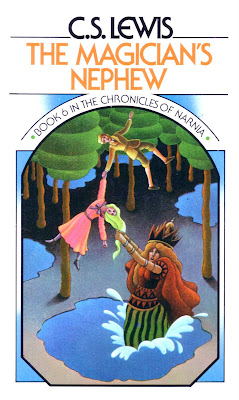The Horse and His Boy
(1954) is a children’s fantasy novel, the fifth in C. S. Lewis’s
Chronicles of Narnia. Here, an adopted lower-class boy, a young, independent girl, and two Narnian talking horses attempt to flee from Calormen into Narnia; on the way, they get caught up in international political intrigue.
While Lewis wrote this book fifth, it takes place during the original reign of the Pevensies during the last chapter of The Lion, the Witch and the Wardrobe. The only reason for this chronological decision is so that Lewis can bring the Pevensies back in supporting roles, which he does (plus Mr. Tumnus). And it is nice to see them as adults, more mature but still distinctly the same characters.
I trust it will not be too great an affront to Lewis to say that this story reads like The Prince and the Pauper by way of Arabian Nights. Not that there’s anything wrong with the story; it’s well-told, but it doesn’t feel particularly imaginative, and that’s what separates the good Narnia stories from the great ones. The Horse and His Boy feels too much like Lewis took a number of trusty old story elements and gave them the Narnia treatment.
This is the only book in the series where children from Earth are not prominent characters (there’s not much time spent in Narnia, either), and that alone gives The Horse and His Boy a different feel from the rest. But this isn’t Lewis’s best set of characters. Shasta is decent enough, but I feel like we’ve seen him before, in Twain and elsewhere. While the horses have their own personalities, they don’t add much to the story. A highlight is Aravis (another character we’ve seen before), in whom Lewis has the strongest female character in the series. (Aslan, as usual, steals most of his scenes.)
Lewis offers lessons to be learned, of course. The most obvious theme is pride: the Calormenes are a prideful people in general, and several of the book’s prominent characters have to learn to practice humility. Another is divine providence, which, thanks to Aslan, is present in all the books in a general way, but here is much more pronounced, culminating in Aslan explaining to Shasta how he has been present and involved at every key moment of the boy’s life.
Some critics have pointed to The Horse and His Boy (as well as to The Last Battle) and cried “racism.” In a book where most of the people who are good and right are light-skinned and the warmongering villains are dark-skinned, that’s understandable, but, I think, taking it too far. Certainly Lewis has populated his other Narnia books with light-skinned enemies, and, while he has done Calormen in the style of the medieval Arab world and set this culture up as a rival to Narnia, there is nothing egregiously antagonistic on Lewis’s part here, particularly since he portrays Aravis so sympathetically.
In short, while not Lewis’s best, The Horse and His Boy is another quality adventure.
RECOMMENDED
 is a 1979 Star Wars children’s book featuring characters and events from the infamous 1978 Star Wars Holiday Special. The book is illustrated by Patricia Wynne; no author is credited. Here, Chewbacca returns to his home world for his two-hundredth birthday while his son “Lumpy” gets lost in the swamp.
is a 1979 Star Wars children’s book featuring characters and events from the infamous 1978 Star Wars Holiday Special. The book is illustrated by Patricia Wynne; no author is credited. Here, Chewbacca returns to his home world for his two-hundredth birthday while his son “Lumpy” gets lost in the swamp.




